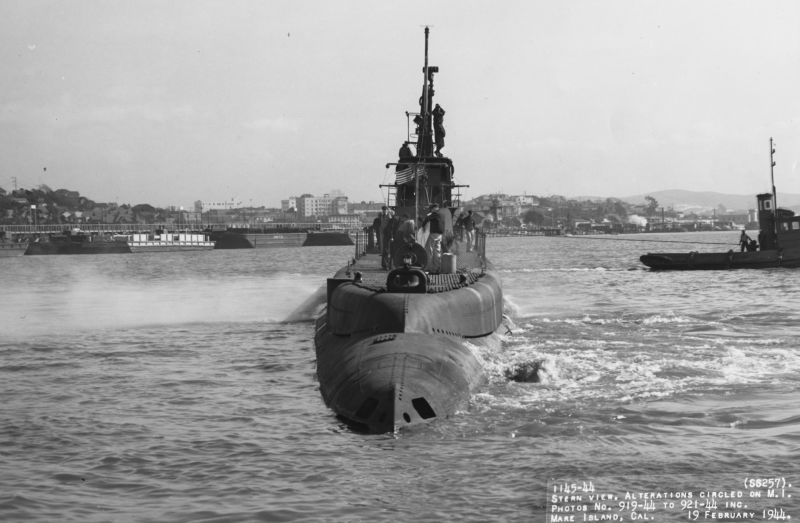
USS Harder Discovery: Legendary US Navy WWII Submarine Located near the Philippines

After eighty years since its final mission, the historic USS Harder, a renowned US Navy submarine from World War II, has been discovered in the waters near the Philippines. This significant find, announced by the Navy's History and Heritage Command, sheds light on the remarkable legacy of this revered submarine.
The US Navy's History and Heritage Command announced on Thursday that the wreck of the USS Harder, one of the most famous submarines of World War II, has been discovered in the South China Sea after 80 years since its last patrol.
According to the NHHC, the USS Harder is resting upright and mostly intact under 3,000 feet (around 900 meters) of water near the northern Philippine island of Luzon. The only visible damage is located behind its conning tower, which was caused by a Japanese depth charge.
Harder and its 79 submariners were lost in battle on August 24, 1944, during their sixth patrol of the war. This occurred as the US was working to reclaim the Philippines from the Japanese forces that were occupying it.
NHHC Director Samuel J. Cox, a retired US Navy admiral, emphasized that Harder was lost in the pursuit of victory. He reminded us that victory and freedom come at a cost that should not be forgotten.
According to a US Navy history, Harder sank two Japanese escort ships off the Bataan Peninsula on August 22, 1944. Then, it headed north along the Luzon coast with two other submarines in search of more targets.
U.S. Navy archive photo of USS Harder.
U.S. Navy archive photo of USS Harder.
Naval History and Heritage Command
According to Japanese records cited by NHHC, Harder fired three torpedoes at Japanese escort ship CD-22 on the morning of August 24. However, all three torpedoes missed and Harder was later sunk by the Japanese ship's fifth depth charge attack.
The NHHC confirmed the wreck of the Harder with data provided by the Lost 52 Project. This project, led by Tim Taylor, CEO of Tiburon Subsea, aims to locate the 52 US submarines lost during World War II.
The NHHC said the group has found at least six WWII subs in the past.
Cox from the NHHC expressed gratitude to Lost 52 for allowing them to honor the crew of the 'Hit 'em Harder' submarine once more, referencing the vessel's motto.
The wreck identified by the NHHC is a significant historical site where Sailors lost their lives defending the nation. It should be treated with respect as a war grave.
During World War II, the Philippines, which was a US territory at the time, was attacked by Japan shortly after the bombing of Pearl Harbor in December 1941. By the spring of 1942, US and Philippine forces on Luzon surrendered to Japan's forces. Japan then used the captured archipelago to safeguard its supply routes from the East Indies and Southeast Asia.
By mid-1944, the US was pushing back Japanese advances in the Pacific and preparing for operations in the Philippines.
The submarine Harder, commanded by Cmdr. Samuel Dealey and known for its motto "Hit 'em Harder," played a significant role in the war. Dealey would later receive the Medal of Honor for his heroic actions during Harder's fifth patrol from March to July 1944.
Harder sank three Japanese destroyers during that time, with another two likely destroyed or heavily damaged in just four days, as reported by the National Medal of Honor Museum. The museum's page on Dealey recounted one particularly harrowing encounter.
Dealey faced an attack from a Japanese destroyer and made a bold move by ordering a head-on torpedo shot at the enemy's bow, a tactic known as a "down the throat" shot, as mentioned in the museum's account.
The intense moment unfolded as Dealey fired three torpedoes at the enemy from a distance of 1,500 yards. With precision, he then instructed the submarine to dive. The Harder swiftly passed 80 feet beneath the destroyer, hitting the enemy with two torpedoes that caused shock waves through the submarine.
On its first four patrols after commissioning on December 2, 1942, Harder sank 14 Japanese warships and merchant vessels, according to the Medal of Honor Museum.
Editor's P/S:
The discovery of the USS Harder's wreck is a poignant reminder of the immense sacrifices made by our brave servicemen during World War II. It is a somber reminder of the fragility of life and the profound cost of war. As we stand in awe of the wreck's preservation after 80 years, we honor the memory of the 79 submariners who lost their lives in the pursuit of victory. Their unwavering determination and courage serve as an enduring testament to the spirit of the Greatest Generation.
The wreck of the Harder also holds immense historical significance. It is a tangible link to a pivotal moment in our nation's history, when the United States fought tirelessly to liberate the Philippines from Japanese occupation. By preserving and studying the wreck, we can gain deeper insights into the events of that time and the heroic efforts of those who served. It is a reminder of the importance of remembering the past and honoring the sacrifices made by those who came before us.







